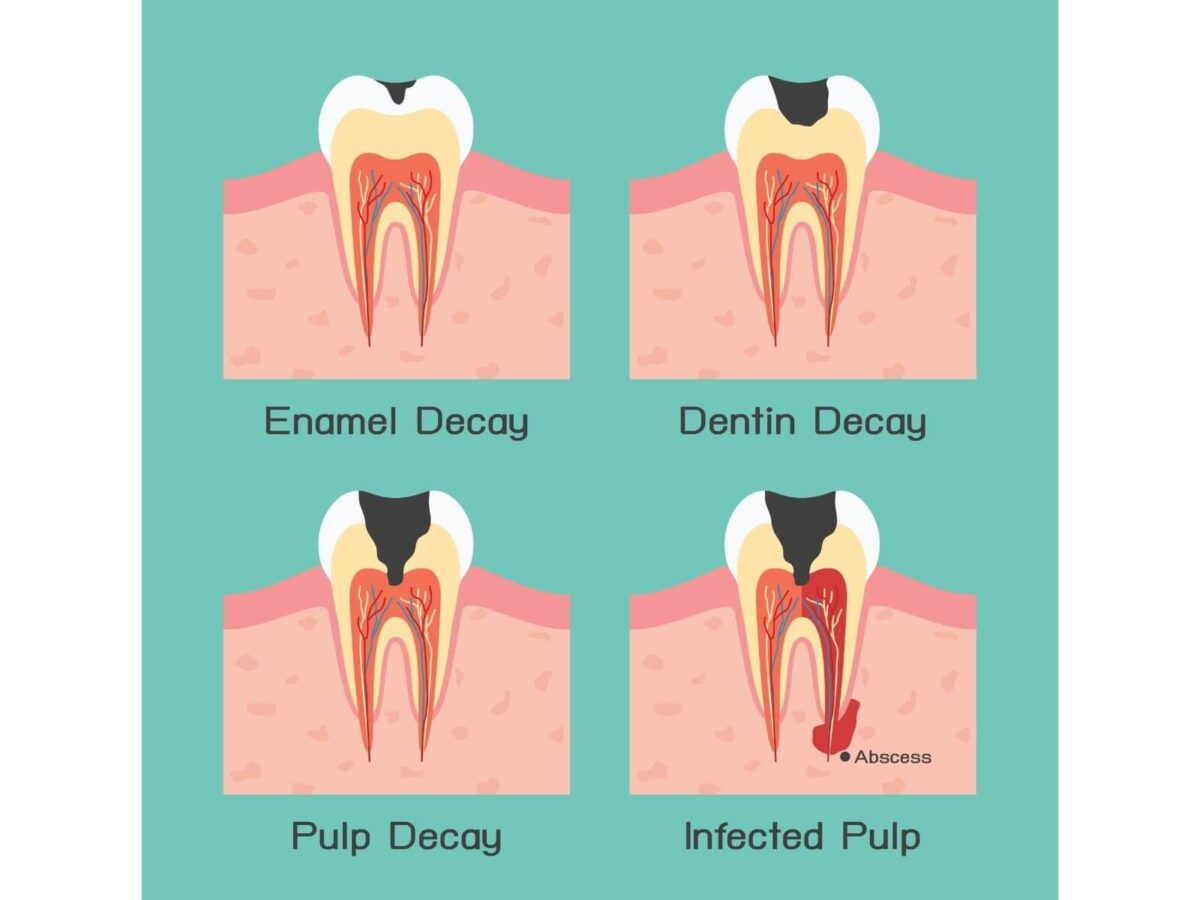Blog
Dental hygiene tips for healthy teeth & gums

Understanding The Stages of Tooth Decay
Tooth decay stands as the primary source of tooth pain among patients. Ample areas of decay appear on teeth when the enamel starts to deteriorate. The acidic environment inside dental plaque breaks down tooth tissue because certain bacteria in the plaque process sugar residues in saliva. Your dental visits and good oral health routines can successfully treat teeth that have decayed.
What Causes Tooth Decay?
Decaying teeth develop due to several leading causes.
- Bacteria connect themselves to teeth and shape plaque that builds up during life.
- The plaque microorganism, notably Streptococcus mutans, feeds on sugar to produce dangerous acids that destroy the tooth enamel.
- Bacteria reproduce quickly as we devour sugary objects and bread, cereal, and soda.
- Plaque microorganisms break down dietary sugar into lactic acid, which eliminates minerals from teeth.
- Saliva performs a protective role; however, it fails to carry out this function when there is no moisture to properly clean and restore broken tooth surfaces.
Stages of Tooth Decay
Stage 1: Demineralization
Developing tooth plaque leads to calcium loss in demineralization. Plaque bacteria consume sugar from your diet and create acid during sugar metabolism. The acid flows over tooth enamel to create visible white spots in areas the disease has affected.
Treatment
An essential fluoride treatment will restore the minerals your tooth gave up during this phase. The basis of this remedy method is referred to as remineralization. To enhance teeth’ enamel strength, use fluoride toothpaste and fluoride water or receive treatment from your dentist.
Stage 2: Enamel Decay
The damaged enamel remains vulnerable when bacteria from plaque keep destroying your tooth surface. Due to ongoing toxicity, the body fails to replace lost minerals, making tooth enamel degrade. When the plaque attack continues, the original white marks on your teeth turn darker into brown tones.
The bacteria damage will create a tooth lesion that will develop into a cavity under continued neglect.
Treatment
The dentist will use a dental filling to treat tooth enamel decay with excellent results.
The dentist removes and fills the damaged area of your tooth with material that matches your tooth color during this treatment.
Stage 3: Dentin Decay
The untreated decay on your tooth enamel will reach the dentin area next. The soft dentin structure allows acid to destroy the tooth at a faster rate than through enamel only.
People with dentin decay feel high sensitivity when eating hot or cold items or consuming sugary food. Visit your dentist right away when dental sensitivity starts impacting your teeth.
Treatment
Treatment selection depends upon the extent of damage and includes filling and crown placement options.
Stage 4: Pulp Decay
The decay process has now reached the tooth’s core, and the tooth has been opened. You will intensely experience pain from the damaged tooth at this point. When tooth decay reaches the heart of the tooth, it will start adversely affecting the blood vessels and causing nerves to ache.
Treatment
When decay damages the tooth pulp, a root canal process is critical to store dental health. The inflamed pulp could be eliminated before crowning over the enamel to protect the nerves.
Stage 5: Abscess
Bacterial infection in the tooth root leads to an abscess as it spreads deeper. If not treated quickly, the abscess will damage bone and tissues in the jaw.
Treatment
A root canal procedure is needed to remove the infection before it expands further within the tooth.
The doctor will need to remove the tooth in extreme cases.
How We Treat Tooth Decay
Tooth decay at its beginning stage can be treated and reversed through better oral care and hygiene practices. People must brush their teeth properly every day, clean between them with floss, and use fluoride products to protect them. Our doctors have to perform strong treatment methods to address significant tooth damage from plaque bacteria.
Our dentists place fillings and crowns over affected teeth to shield them after extensive bacterial damage reaches the inner tooth layers. Because patients dislike cosmetic restorations, we select tooth-colored filling materials for their teeth. The installed restorations remain unseen but keep giving our patients their required protection.
How to Prevent Tooth Decay
People can control tooth decay effectively. Regular oral care using these protective steps will defend against tooth decay.
Clean your teeth effectively with fluoride products and an electric toothbrush as part of your daily oral care routine. Daily oral care efforts maintain oral health and serve better than other measures to protect your teeth.
Eat fewer sugary foods and do not consume meals between daily meals.
Water consumption leads to saliva production, which protects teeth and washes away particles from the liquid it gives.
The best way to forestall enamel decay is through regular visits to your dental expert, who promotes proper oral health.
Conclusion
Regular dental checkups are the most effective technique to prevent and start treating enamel decay. A dental examination protects you against developing tooth decay and keeps your teeth healthy through professional cleaning if you do not show signs of decay now. Contact our dental experts at Victoria Dental now for your dental visit.


